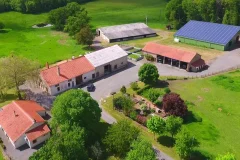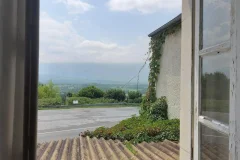Auvergne Description and Information
Auvergne Départements
Auvergne description
The Auvergny History Directly Link to the Volcan
Auvergne, which encompasses much of the Massif Central, is perhaps the least known and most remote région of France. With two large spectacular national parks - the dramatic Parc Naturel Régional des Volcans d'Auvergne and its tamer neighbour the Parc Naturel Régional des Livradois-Forez - it is almost entirely unspoiled and is the largest environmentally protected area of France.
Volcanic activity started here around 20 million years ago so the région's mountains are older than the Alps or the Pyrenees. The youngest volcanoes around the Puy de Dôme are just 5000 years old. The many extinct volcanoes that dimple the landscape make the région a strange, but enigmatically beautiful place. There are also spectacular gorges, and geesers, lakes, streams, rivers and thick vast forests. Hot springs and mineral cold springs attract many curistes who come seeking relief from rheumatism, arthritis and digestive ailments. Auvergne's beauty wasn't, of course, enough to stem an exodus from the région and it is now heavily depopulated and poor. Its ageing population proves there could be some truth in its reputation for being rustic and backwards. (People also have a reputation for being taciturn and not very open to strangers - although this may be an unfair stereotype) Today the population continues to diminish, no longer because of migration to find work, but because the number of births are not superior to the number of deaths. Proportionately the number of people over 75 matches the number under 20. It's predicted that between 2010 and 2030 the population with diminish a further 8%.
Auvergne is the least expensive région for property in France and isn't popular with foreign buyers, although there is a tourist industry - Le Puy-en-Velay, with its strange volcanic skyscrapers is particularly popular, but mostly with visitors passing through on autoroutes to the south or across the borders. For the very active and outdoorsy types, who can take or leave museums and restaurants, Auvergne could make a wonderful base for a second home. Even though the pace of life is slow, there are plenty of thrilling adventures to be had. It is outstanding riding, hiking and mountain climbing country and there are lakes where you can swim, sail, windsurf, and fish. You can also white water raft and kayak through the gorges of the Allier and Sioule rivers. Other outdoor opportunities include paragliding and ballooning.
Skiing is possible in Auvergne
There are several ski resorts so, for the energetic, the Auvergne is an ideal place to visit at all times of year. Summers in Auvergne are long and warm, with temperatures often reaching 30 degrees punctuated by short sharp thunderstorms. The uplands are cooler and at altitudes of over 1000m, snow frequently lies until May. Although much of the région is remote, good road and rail routes pass through and there are air connections nearby.
A surprising Agricultural Region
There is little arable land here and much of the agriculture is upland pasture. The région is famous around the world for its green (Puy) lentils, which have achieved AOC classification thanks to the area's rich volcanic soil. The area produces 60% of France's lentils. Other crops are corn seed and rye. Agriculture employs 15% of the working population. Tire production is the largest industrial sector in Auvergne and led by Michelin which has its headquarters in Clermont-Ferrand. It accounts for one-third of the région's exports, employing 130 000 people worldwide and 20 000 in the région. Michelin also encouraged the development of related industries including metals and metal products, plastics, automobile equipment and mechanical construction and is responsible for advancements in Auvergne's research programs, particularly in the chemicals industry.
Auvergne Population
- Population: 1,308,878
- Pop.density (people per km2): 50
Auvergne is one of the least populated régions in Europe, let alone France. The département of Cantal would be almost completely depopulated if it wasn't for the town Aurillac (36,096).









